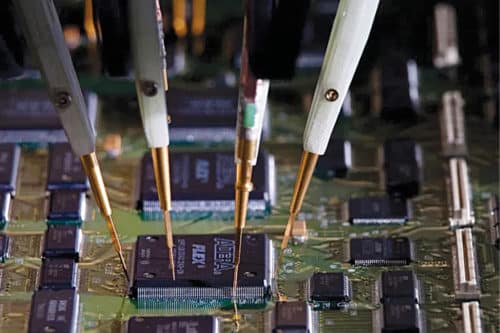Printed circuit board testing is an important task for test engineers. However, with increase in complexity of the circuit, it has become difficult to test it. So, nowadays, most of the industries are using a fully automatic test jig that can run the test and make an automated test report.
Printed circuit board (PCB) testing is an inevitable task for test engineers. With PCB size becoming smaller and complexity of the circuit increasing, it has become difficult for engineers to perform testing. With a large number of PCBs to test, keeping records manually is not possible. Moreover, sharing all documents is also a difficult task as, generally, testing is not done by original equipment manufacturers (OEMs).
One solution that most of the industries are now using is a simple bed of nails test jig in which a test engineer has to select the switches manually and note down the test point values. But doing things manually can cause errors.
So, the solution to the above problem is to use a fully automatic test jig that can run the test and make an automated test report.
To build an automated test jig use a bed of nails test jig and connect all test points of the device under test (DUT) to the data acquisition board (DAQ). This process will acquire all test points as per the test specified, apply some pass-fail criteria, and finally give a report. DAQ board can be fitted inside the test jig.
The DAQ board runs using an automated software like LabVIEW or Visual Basic. It can be customised as per requirements, or a standard DAQ from the market can be used.

Data for test jig manufacture
The data required for manufacturing test jigs are as follows:
- Gerber files of the device under test
- List of test points and their positions. Normally, through-hole test points are used, but in some cases, SMD points can also be taken
- DAQ board size with connectivity drawings
- Any other PCBs required for testing DUT
- Cables coming in or out of the jig
- Power supply for DUT
- Connectors for the test jig
Automated software
There are other software as well for automating the test, but the most commonly used software programs are LabVIEW and Visual Basic.
LabVIEW
It is a software made by NI, formerly known as National Instruments Corporation. It uses a graphical programming language. With some knowledge, it can be used for automating tests and generating test reports.
Visual Basic
It is a very old programming language used by engineers. With some knowledge and experience, one can easily automate the tests.
Normally, software architecture has three main steps:
Initialisation. In this, all logic for power-up and configuration are done
Testing. In this, all sequences of the test can be done
Clean up. In this, all shutdown logic can be implemented
Test reports
The test report is the most important part of the test. Reports should be easy to read and transfer to concerned people.
Normally used format is .csv or xls. The advantage is that it is very easy to create, and most software can read it like Excel and Open Office. The disadvantage is that format may change while importing the files. This can be solved by some delimiters, but for large data, it is a very difficult and time-consuming task.
Another format is HTML, which is useful in making a colourful report. Pass and fail tests can be easily marked for the user. Also, HTML files can be viewed on a normal browser, which is a great advantage for some.
PDF is also one of the most popular formats used for test reports. Making reports in PDF may require some plug-ins, which depends upon the test software.
Data storage
Storing the data is the last stage of the test, which is not taken care of by many users. Test data can be stored directly in some folders or a database.
The advantage of storing test data in a database is that it cannot be easily deleted, and only an authorised person can access it. One more advantage of storing the data in a database is that one can analyse the stored test data for debugging.
Cost
Finally, whether to go for automated testing or not depends on the number of DUT to be tested in a day or month. For example, if you have more than thirty DUT to test in a day, it is a good criterion to go for automated tests.
The cost of an automated test jig depends on many factors like the number of test points, the complexity of the test, and the size of DUT. The cost can be divided into mechanical structure, DAQ board design, and software design. Normally, for a board with thirty test points, the cost can go up to ₹ 50,000.
Time and training for users
The time required for testing thirty test points test jigs would not be more than five minutes. However, complex tests require more time.
Extensive training is not required as the user will only monitor the test. In some cases, basic training for DUT and automation software application usage is required.
Conclusion
More and more electronic industries are shifting to automated tests from manual tests. This saves time and resources like multimetres, function generators, and oscilloscopes. Design teams can focus only on the design part. Some EMS vendors also support test jigs.
Sachin Kudari works as test system designer for a private company






